Maria Ngu-Schwemlein

Position: Professor Department: Chemistry
Contact Info
Office: 309 W.B. Atkinson Science Bldg. Phone: 336-750-2919 Fax: 336-750-2545 Email: schwemleinmn@wssu.edu
Biography
Dr. Maria Ngu-Schwemlein received her B.Sc. degree in Chemistry, with Honors, in 1985 from LaTrobe University, Victoria, Australia. In 1989, she earned her Ph.D. degree in Medicinal/Organic Chemistry at the John Curtin School of Medical Research at the Australian National University (ANU) in Canberra, Australia. She is a Professor of Bioorganic Chemistry in the Department of Chemistry. Her research interests are in peptide derived ligands for metal ions sensing and as potential antimicrobial agents. She is formally trained in medicinal chemistry and has more than eighteen years of experience in teaching and advising both graduate and undergraduate students. Since joining Winston-Salem State University in 2006, she has received funding from both NSF and NIH for her research in antimicrobial and metal ion binding peptides. Dr. Ngu-Schwemlein is a member of the national American Chemical Society, American Peptide Society, and the Council for Undergraduate Research (UCUR).
Educational Background
- PhD, Medicinal/Organic Chemistry, 1989, The Australian National University, Australia
- BSc, (Honors), Chemistry, 1985, LaTrobe University, Australia
Research and Project Interests
- Rational Design of Cysteinyl Peptide Ligands as Chelators of Mercury(II)
- Enhancing In Vitro Antimicrobial Activity of Common Antibiotics with Cyclopeptides
Carbon nanodots as molecular scaffolds for development of antimicrobial agents, Maria Ngu-Schwemlein, Suk Fun Chin, Ryan Hileman, Chris Drozdowski, Clint Upchurch, April Hargrove, Bioorganic & Medicinal Chemistry Letters, 2016, 26(7), 1745–1749.
Synthesis of yellow fluorescent carbon dots and their application to the determination of chromium(III) with selectivity improved by pH tuning, Melissa May Fung Chang, Irine Runnie Ginjom, Maria Ngu-Schwemlein, Sing Muk Ng, Microchimica Acta, 2016, in press.
A Study of the Complexation of Mercury(II) with Dicysteinyl Tetrapeptides by Electrospray Ionization Mass Spectrometry, Johanna Mazlo, Maria Ngu-Schwemlein, Journal of Visualized Experiments, 2016, 107, e53536. doi:10.3791/53536
In vitro synergy between some cationic amphipathic cyclooctapeptides and antibiotics, Maria Ngu-Schwemlein, Jenna Dumond, Lisa Rudd, Jean-Herbert Rigaud*, Australian Journal of Chemistry 2015, 68, 218-223.
Synthesis and ESI mass spectrometric analysis of the association of mercury(II) with multi-cysteinyl peptides, Maria Ngu-Schwemlein, Xiuli Lin, Brent Rudd, Matthew Bronson*, Journal of Inorganic Biochemistry, 2014, 133, 8-23.
Evaluation of the association of mercury(II) with some dicysteinyl tripeptides, X. Lin, J. Brooks*, M. Bronson*, M. Ngu-Schwemlein, Bioorganic Chemistry, 2012, 44, 8-18.http://dx.doi.org/10.1016/j.bioorg.2012.06.001
Secondary Structural Preferences of Some Antibacterial Cyclooctapeptides in the Presence of Calcium(II), Tarshona Stevens*, NykiaMcNei*l, Xiuli Lin, and Maria Ngu-Schwemlein, International Journal of Medicinal Chemistry, 2012, Article ID 730239, doi:10.1155/2012/730239
1,2-Dihydro-9H-carbazole-4(3H)-thione, W.A. Phelan, M. Ngu-Schwemlein, F.R. Fronczek, M.L. McLaughlin, S.F. Watkins, Acta Crystallographica, 2011, E67, o757.
Thermodynamics of the complexation of Hg(II) by cysteinyl peptide ligands using isothermal titration calorimetry, M. Ngu-Schwemlein, J. Merle, Patrick Healy*, S. Schwemlein*, Sade Rhodes*, Thermochimica Acta, 2009, 496, 129-135.
Fluorogenic Cyclooctapeptides and Metal Ion Sensing. M. Ngu-Schwemlein, L. Garcia, A. Kshawna*, In Proceedings of the Twentieth American Peptide Symposium Series: Advances in Experimental Medicine and Biology, Vol. 611, Peptides for Youth, (E. Escher, W. D. Lubell, S. D. Valle, Eds), 2009, pg. 87-8.
Thermodynamics and Fluorescence Studies of the Interactions of Cyclopeptides with Hg2+, Pb2+ and Cd2+, Maria Ngu-Schwemlein, Willie Gilbert*, Kshawna Askew*, Stefanie Schwemlein*, Bioorganic and Medicinal Chemistry, 2008, 16 (10), 5778-5787.
Recombinant Expression of the b subunit of HLA-DR10 for the Selection of Novel Lymphoma Targeting Molecules, Huguette Albrecht, Monique Cosman, Maria Ngu-Schwemlein, Michele Corzett, Kena W. Curran, Cheryl Dolan, Xiangming Fang, Sally J. DeNardo, Gerald L. DeNardo and Rod Balhorn, Cancer Biother Radiopharm. 2007 22(4):531-42.
Interactions of an Acidic Cyclooctapeptide with Metal Ions: Microcalorimetric and Fluorescence Analyses, Maria Ngu-Schwemlein, Peter Butko, Brian Cook*, Tiffany Whigham*, J. Peptide Research, 2005, 66 (Supplement s1), 72-81.
Amphipathic Cyclooctapeptides: Interactions with Detergent Micelles and Metal Ions. William Day Gates*, Jack Rostas*, Bobby Kakati*, and Maria Ngu-Schwemlein, J. Mol. Str., 2005, 733(1), 5-11.
Extracellular Domain of Myelin Oligodendrocyte Glycoprotein (MOG) Exhibits Solvent-Dependent Conformational Transitions. Maria Ngu-Schwemlein, Michele Corzett, Kevin H. Thornton, Rod Balhorn, Monique Cosman, Protein and Peptide Lett., 2003, 10 (5), 483-490.
Synthesis and Calcium Interactions of Model Amphiphatic Cyclic Peptides in Detergents. Day Gates*, Jack Rostas*, Victor Bailey*, Maria Ngu-Schwemlein, In Proceedings of the Eighteenth American Peptide Society Symposium (Chorev, M. and Sawyer, T.K., Eds), 2003, 424-425.
Cyclotetrapeptides with alternating D-Ala residues: synthesis and spectroscopic studies. M. Ngu-Schwemlein, F. Zhou, T. Bowie*, R. Eden*, J. Mol. Str., 2003, 655 (1), 59-68.
Synthesis of Paucidisperse Poly(gamma-benzyl-alpha, L-glutamate) Oligomers and Star Polymers with Rigid Arms. X. Wang, W. Daly, P. Russo, M. Ngu-Schwemlein, Biomacromol., 2001, 2(4), 1214-1219.
CD Evidence of Conformational Transitions in rMOG[1-125] in the Presence of Membrane Mimicking Detergents. M. Ngu-Schwemlein, M. Corzette, R. Balhorn, M. Cosman, In Proceedings of the Seventeenth American Peptide Society Symposium (Houghten, R.A. and Lebl, M., Eds), 2001, 334-5.
Conformational Studies of Cyclotetrapeptides [Xaa-D-Ala]2 by NMR, CD and Molecular Modeling. M. Ngu-Schwemlein, T. Bowie*, R. Eden*, F. Zhou, In Proceedings of the Seventeenth American Peptide Symposium (Houghten, R.A. and Lebl, M., Eds), 2001, 287-8.
Polymeric Cyclic Peptides as Self-Assembling Biopolymers. M. Appeanin*, C. Agbasi*, M. Ngu-Schwemlein, Proceedings of the 26th Annual NOBBChE Conference, 1999, 26, 109-116.
Imidazo[1,2-b]pyridazines. XXII. Syntheses of Some 2-Aryl-3-methoxy-6-(pyridinylmethylthio and pyridinylmethylamino)imidazo[1,2-b]pyridazines and their Interaction with Central and Mitochondrial Benzodiazepine Receptors. G.B. Barlin, L.P. Davies, S.J. Ireland, M. Ngu-Schwemlein, Aust. J. Chem., 1997, 50, 91-95.
Synthesis of gama-Benzyl-alpha, L-glutamate Oligomers and their Star Derivatives. X. Wang, W. Daly, M. Ngu-Schwemlein, Polymer Preprints, 37(1): 622-623, 1996.
A Practical Method for Preparing Peroxynitrite Solutions of low Ionic Strength, free of Hydrogen Peroxide. W.A. Pryor, R. Cueto, X. Jin, W.H. Koppenol, M. Ngu-Schwemlein, G.L. Squadrito, R.M. Uppu, Free Radical Biol. Med., 18:75-83 (1995).
Substituted imidazo[1,2-b]pyridazines. New Compounds with activity at Central and Peripheral Benzodiazepine Receptors. L.P. Davies, G.B. Barlin, S.J. Ireland, M.M.L. Ngu, Biochem. Pharm., 1992, 44, 1555.
Imidazo[1,2-b]pyridazines. VIII. Syntheses and Central Nervous System Activities of Some 6-Benzylamino(and methoxybenzylamino)-3-methoxy-2-phenyl (substituted phenyl or pyridyl)imidazo[1,2-b]pyridazines. G.B. Barlin, L.P. Davies, and M. Ngu, Aust. J. Chem., 1989, 42, 1759.
Imidazo[1,2-b]pyridazines. VII. Syntheses and Central Nervous System Activities of Some 3-Alkoxy-6-benzyloxy(methoxybenzyloxy)-2-phenyl (substituted phenyl or pyridyl)imidazo[1,2-b]pyridazines. G.B. Barlin, L.P. Davies, and M. Ngu, Aust. J. Chem., 1989, 42, 1749.
Imidazo[1,2-b]pyridazines. VI. Syntheses and Central Nervous System Activities of Some 3-(Alkoxy- and methylthio-phenoxy and methoxybenzylthio)-3-methoxy-2-phenyl(substituted phenyl and pyridyl)imidazo[1,2-b]pyridazines. G.B. Barlin, L.P. Davies, S.J. Ireland and M. Ngu, Aust. J. Chem., 1989, 42, 1735.
Imidazo[1,2-b]pyridazines. V. Syntheses and Central Nervous System Activities of Some 3-Alkoxy-6-benzylthio(substituted benzylthio and other phenylalkylthio)-2-(and substituted phenyl)imidazo[1,2-b]pyridazines. G.B. Barlin, L.P. Davies, and M. Ngu, Aust. J. Chem., 1989, 42, 1133.
Imidazo[1,2-b]pyridazines. IV. Syntheses and Central Nervous System Activities of Some 3-Methoxy-6-phenoxyimidazo[1,2-b]pyridazines. G.B. Barlin, L.P. Davies, and M. Ngu, Aust. J. Chem., 1988, 41, 1735.
Imidazo[1,2-b]pyridazines. III. Syntheses and Central Nervous System Activities of Some 6-Chloro-3-methoxy(and ethoxy)-2-aryl(and heteroaryl)-imidazo[1,2-b]pyridazines. G.B. Barlin, L.P. Davies, and M. Ngu, Aust. J. Chem., 1988, 41, 1149-1156.
An Improved Synthesis of Porphyrin C. P.A. Scourides, G. Morstyn, and M. Ngu, J. Chem. Soc., Chem Commun., 1986, 1917.
Heterocyclic Amplifiers of Phleomycin. X. Derivatives of Diazine Mono- and Di-thiols. G.B. Barlin, D.J. Brown, B.J. Cronin, and M. Ngu, Aust. J. Chem., 1986., 39: 69-75.
- Intro to Scientific Research CHE/BIO 1325
- Biochemistry I (CHE 3346)
- Biochemistry II (CHE 4346)
- Biochemistry II Lab (CHE 4246)
- Organic Chemistry I (CHE 3326)
- Organic Chemistry I Lab (CHE 3126)
- Organic Chemistry II (CHE 3327)
- Organic Chemistry II Lab (CHE 3127)
- General Chemistry I (CHE 2311)
- Freshman General Chemistry (including computer-assisted instructions)
- Survey of Inorganic and Organic Chemistry for Nurses
- Sophomore Organic Chemistry
- Intermediate Organic Chemistry
- Special Topics in Organic Chemistry - Peptide Chemistry
- Biochemistry for Food Nutrition, Animal Science and Agro majors
- Biochemistry for Chemistry and Biology majors (2-semesters Biochemistry)
- Biochemistry Laboratory for Chemistry majors (biochemical and biotechnology experiments)
- Macroscale and microscale techniques in General and Organic Chemistry Laboratory Classes
Project #1
AAAS WIRC-MI: International collaboration in cysteinyl-peptide functionalized carbon nanodots as chelators and sensors for mercury ion
Principal Investigator: Dr. M. Ngu-Schwemlein
International Collaborators: Dr. Chin Suk Fun, Advanced Material Group at University Malaysia Sarawak (UNIMAS) and Dr. Ng Sing Muk, School of Engineering, Computing, and Science at Swinburne University of Technology Sarawak (SUTS).
Project Summary
The long-term goal of this project is to design effective peptide functionalized nanomaterial for mercury(II) binding and sensing. The specific aims of this study are to design and synthesize some cysteine-containing peptide carbon nanodots, evaluate their mercury(II) binding affinity, and assess their mode of binding and fluorescence signal so as to enhance the development of cysteinyl-peptide derived carbon nanodots for chelation and sensing applications. In working toward this goal, the scientific objectives of this planning project are (i) to develop a better understanding of the passivation and functionalization of carbon nanodots, derived from Malaysian sago starch nanoparticles, to bind mercury(II), and (ii) to evaluate cysteinyl-peptide functionalized carbon nanodots as a sensing receptor for mercury(II) detection by fluorescence. The scientific findings from this study will be extremely useful for developing peptide functionalized nanomaterials as mercury(II) chelating and sensing agents for potential applications in environmental remediation, chelation therapy, and sensing.
Funding Acknowledgement
“AAAS WIRC-MI: International collaboration in cysteinyl-peptide functionalized carbon nanodots as chelators and sensors for mercury ion”, PI (Maria Ngu-Schwemlein): 11/1/2012-12/31/201
Project #2
Synergistic Antimicrobial Peptides
Principal Investigator: Dr. M. Ngu-Schwemlein
Department: Chemistry
Project Summary
Antimicrobial resistance for both Gram-positive and -negative pathogens has spread worldwide at an increasing rate, presenting a challenging global health problem. Even in the U.S., hospital- and community-acquired methicillin-resistant Staphylococcus aureus (MRSA) have became more virulent and can cause a greater spectrum of illness than their predecessors. In particular, MRSA has been found to exhibit an alarming ability to strike otherwise healthy people. One strategic approach to preventing antibiotic resistance is to treat bacterial infections with more than one drug at a time. Synergies of interaction can both increase the efficacy of the combination and reduce the probability of the bacterium’s surviving by developing a double fortuitous mutation conveying resistance. We propose to investigate the potential of amphipathic cationic cyclopeptides, which are capable of disrupting the bacterial membranes, to elevate the efficacy of some clinically used antibiotics against several types of Gram-positive and -negative bacteria. These amphipathic cationic cyclopeptides, like the better-known polycationic peptides, could enhance the uptake of small hydrophobic molecules into the bacterium and present synergistic effects.
The long-term goal of this project is to design-fast acting antimicrobials that may lead to novel antimicrobial therapeutic routes, for example, they can provide synergism in combination antimicrobial therapy or act as a scaffold for antibiotic targeting. The objectives of this project are (i) to develop a clearer understanding of the interaction of cationic cyclooctapeptides with bacterial membrane and its associated divalent metal ions (Ca2+ and Mg2+) by a structure-and-binding correlation study, (ii) to identify the origins of the binding specificity between the donor atoms on the cyclooctapeptide and Ca2+ or Mg2+ by solid state studies, and (iii) to utilize these understandings to develop effective antimicrobials.
In working towards these project objectives, we will synthesize a series of amphipathic cationic cyclopeptides and their bis-analogs by microwave-assisted solid-phase-peptide synthesis and evaluate their in vitro intrinsic antimicrobial activities against several strains of bacteria by conducting minimum inhibitory concentration (MIC) assays bacterial killing assays. Their interactions with membrane-mimicking detergents and divalent metal ions associated with stabilizing bacterial membrane will be conducted by isothermal titration calorimetry (ITC), circular dichroism and X-ray diffraction methods. We will also investigate their interactions with some common clinically used antibiotics and assess for synergistic, additive, or antagonistic effects using minimum inhibitory concentration (MIC) assays and checkerboard titrations.
These fundamental studies are expected to demonstrate the potential of this class of bacterial membrane-disrupting molecules in enhancing the efficacy of some antibiotics and in prevailing over antibiotic resistance. Consequently, these research findings could be useful in improving public health.
Funding Acknowledgement
“Enhancing In Vitro Antimicrobial Activity of Common Antibiotics with Cyclopeptides”, NIH NIGMS SC3, Grant # 1SC3GM088134-0, PI, 8/01/2009-7/31/2014.
Project # 3
Rational Design of Cysteinyl Peptide Ligands as Chelators of Mercury(II)
Collaborating Principal Investigators: Dr. M. Ngu-Schwemlein,
Dr. J. Merle, and Dr. S. Fakayode
Project Summary
The long-term goal of this project is to design effective peptide-derived chelating agents for mercury(II). The specific aims of this study are to design and synthesize some cysteine (Cys)-containing peptide ligands, evaluate their mercury(II) binding affinity, and assess their mode of binding so as to enhance the development of Cys-peptide derived ligands for chelation therapy. In working toward this goal, the scientific objectives of this project are (i) to develop a clearer understanding of the interaction of Cys-peptide ligands with mercury(II) by a structure and binding activity relationship study of a series of these peptides, (ii) to identify the origins of the binding specificity between the donor atoms on the Cys-peptide ligands and this heavy metal ion by theoretical calculations and solid state studies, and (iii) to understand the interactions of these Cys-peptide ligands and their mercury(II) complexes with some endogenous biomolecules (glutathione and serum albumin). The scientific findings from this study will be extremely useful for developing peptide-derived ligands as chelators of mercury(II). Cys-peptide ligands consisting of tri-, tetra- and pentapeptides will be prepared by solid phase peptide syntheses. Their mercury(II) binding and associated thermodynamic parameters will be evaluated by isothermal titration calorimetry. Ground-state properties of some Cys-peptides and their respective mercury(II) complexes will also be investigated by X-ray diffraction methods and theoretical calculations using density functional theory. The molecular interactions of these Cys-peptide ligands and their mercury(II) complexes with some endogenous biomolecules will be monitored by fluorescence and circular dichroism spectroscopies.
The results of this collaborative research study will report the significance of Cys-peptide ligands and some of their analogues as selective mercury(II) chelating agents. They could be promising as chelation therapy agents. The class of mercury(II) chelating compounds proposed here are peptides, which could also be explored subsequently for the possibility of using recombinant DNA technology to encode peptide analogues in transgenic plants for mercury(II) phytoremediation. Understanding the nature of the Cys-peptide and mercury(II) binding processes will also provide knowledge extremely useful for the design of chemosensing molecules for mercury(II) and other toxic heavy metal ions. Additionally, the peptide ligand-serum albumin interaction studies will result in further understanding of the principles of molecular recognition and conformational changes as a result of ligand-protein interactions. These should complement current understandings from studies involving serum albumin and its role in the transport of amino acids, metal ions and pharmaceutical drugs.
Funding Acknowledgement
“RUI: Rational Design of Cysteinyl Peptide Ligands as Chelators of Mercury(II)”, NSF Grant # CHE1011859, PI (Maria Ngu-Schwemlein), Co-PIs (John Merle, Sayo Fakayode: 7/15/2010-6/30/2014.
RUI: Rational design of cysteinyl peptide ligands as chelators of mercury (II)
Project #4
Design and Synthesis of Peptide Based Macrocycles as Chemosensors for Metal ions
Principal Investigator: Dr. M. Ngu-Schwemlein
Co-PI: Dr. E. Cioffi
Department: Chemistry
Our research group is working towards the development of chemosensing molecules that bind metal ions and signal specific metal ion binding. Chemosensors for the detection of metal ions with high selectivity and specificity have wide applications in environmental chemistry and the medical sciences. Specifically, peptide-based chemosensors form an interesting class of sensors and have been designed for the detection of some metal ions whereby the donor atoms for metal ion complexation resides within the peptide and ion binding modifies the emission properties of intrinsic or extrinsic fluorophores. Currently we are synthesizing peptide derived macrocycles with structural and chemical properties for selective metal ion binding. The size of the macrocyclic ligand, the peptide derived backbone scaffold, donor atoms for metal ion binding and the stereochemistry of the amino acid residue can be readily altered to tailor the chelation of the metal ion in an environment of interest. Such chemical modifications will enable a systematic structure-and-property relationship study of this type of metal ion binding macrocyclic ligands. We are also working towards the design and synthesis of peptide based macrocyclic ligands with a fluorescent signal to indicate metal ion binding. The metal ion binding selectivity by these macrocyclic ligands are comparatively studied by NMR, CD, ITC, potentiometry and fluorescence techniques.
RUI: Rational Design of Fluorogenic Cyclopeptides as Sensors for Metal Ions
20th American Peptide Symposium, Montreal, Canada, June 25-30, 2007: Fluorogenic Cyclooctapeptides and Metal Ion Sensing. M. Ngu-Schwemlein, L. Garcia, A. Kshawna.
NSF Joint Annual Meeting, Washington DC, June 16-19, 2008: Implementation of a Biochemistry Concentration to Enhance the Undergraduate Biochemistry Experience, M. Ngu-Schwemlein, J. Harp, A. Mohammed
POGIL Southeast Regional Annual Meeting, Statesboro, GA, July 27-29, 2009: Improving Student Achievement in Sophomore Organic Chemistry by Enhancing Active Learning with Technology. Maria Ngu-Schwemlein
238th National American Chemical Society Meeting, Washington DC, August 16-20, 2009:
Guided Inquiry Learning in the Chemistry Laboratory Experience, Abdul Mohammed, Sayo Fakayode, Mamudu Yakubu, Maria Ngu-Schwemlein.
POGIL Southeast Regional Annual Meeting, Williamsburg, VA, June 30-July 2, 2010: Guided Inquiry Learning in the Chemistry Laboratory Experience, Mamudu Yakubu, Maria Ngu-Schwemlein, Sayo Fakayode, Abdul Mohammed, Angela King.
240th National American Chemical Society Meeting, Boston, MA, Division of Medicinal Chemistry August 22-26, 2010: Synthesis and structural studies of the antimicrobial action of some amphipathic cyclopeptides, Maria Ngu-Schwemlein, Nykia McNeil, C-F Zhu, Melissa Bovell.
242th National American Chemical Society Meeting, Denver, CO, Division of Medicinal Chemistry August, 2011: Enhancing In-vitro Antimicrobial Activity of Common Antibiotics with Cyclopeptide
Maria Ngu-Schwemlein, Lisa Rudd, Tarshona Stevens
SERMACS 2011 ACS Southeastern Regional Meeting, Richmond, VA, October 26-29, 2011: A Study of the complexation of Hg(II) with some cysteinyl peptides by electrospray ionization mass spectrometry, Xiuli Lin, Maria Ngu-Schwemlein, Christa Colyer
SERMACS 2012 ACS Southeastern Regional Meeting, Raleigh, NC, November 14-17, 2012: Evaluation of synergism from combination of some cyclopeptides and antibiotics, Jenna Dumond, Lisa Rudd, Jean-Herbert Rigaud, Destiny Walter, Maria Ngu-Schwemlein
246th National American Chemical Society Meeting, Indianapolis, IN, September 8-12, 2013: Elucidation of the association of mercury(II) with cysteinyl peptides for chelation therapy, Maria Ngu-Schwemlein, Xiuli Lin, Matthew Bronson, Brent Rudd
Representative Undergraduate Research Presentations
Sago derived carbon nanodots against multidrug resistant bacteria April Hargrove,Ryan Hileman,Chris Drozdowski, Chin Suk Fun, Maria Ngu-Schwemlein..Winston-Salem State University HBCU UP Summer Undergraduate Research Experience, June 28, 2014
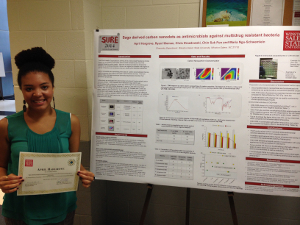
Evaluation of synergism from combination of some cyclopeptides and antibiotics, Jean-Herbert Rigaud, Jenna Dumond, Lisa Rudd, Maria Ngu-Schwemlein. 13th Annual Biomedical Research Conference for Minority Students (ABRCMS), Nashville, TN, November 11-16, 2013

The 12th Annual Poster and Vendor Night, April 3, 2012, Sponsored by Syngenta and the Central North Carolina Section of ACS: Rational design of cysteinyl peptides as chelators of mercury(II), Matthew Bronson, M. Ngu-Schwemlein
(Student Presenter, Matthew Bronson, received the second place award for this research presentation at this meeting)
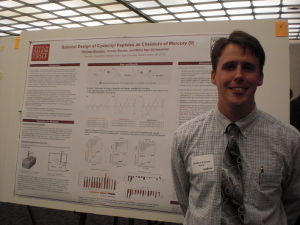
242th National American Chemical Society Meeting, Denver, CO, Division of Analytical Chemistry August, 2011: Rational design of cysteinyl peptide ligands as chelators of mercury(II), Jeremy Brooks, Brent Rudd, Maria Ngu-Schwemlein
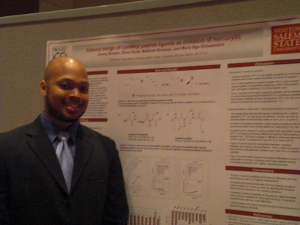
10th Annual Biomedical Research Conference for Minority Students (ABRCMS), Charlotte, NC, November 10-13, 2010: Synthesis and Structure-Antimicrobial Activity Correlation Study of Some Amphipathic Cyclopeptides, Tarshona Stevens, Nykia McNeil, Melissa Bovel, Maria Ngu-Schwemlein.
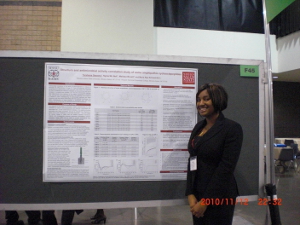
237th National American Chemical Society Meeting, Salt Lake City, UT, March 22-26, 2009: Chelation of mercury (II) by peptide ligands containing cysteinyl and histidyl residues, Sade Rhodes, Aisha Hilliard, John Merle, Maria Ngu-Schwemlein

235th National American Chemical Society Meeting, New Orleans, April 6-10, 2008: Interactions of cyclopeptides containing Cys2His2 or Met2His2 residues and Hg2+, Pb2+ and Cd2+, Kshawna Askew and Maria Ngu-Schwemlein
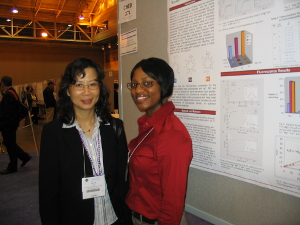
235th National American Chemical Society Meeting, New Orleans, April 6-10, 2008: Thermodynamic studies of the chelation of mercuric ions by amino acids and derivatives, Patrick Healy, Willie Gilbert, Maria Ngu-Schwemlein

HBCU-UP Research Conference, Washington, DC, Oct 4-7, 2007: Cyclopeptides: Metal Ion Binding and Sensing, Willie Gilbert, Stephanie Jackson, Maria Ngu-Schwemlein.
(Student Presenter, Willie Gilbert, received the first place award for this research presentation at this meeting)
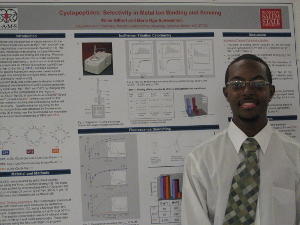
20th American Peptide Symposium, Montreal, Canada, June 25-30, 2007: Fluorogenic Cyclooctapeptides and Metal Ion Sensing. M. Ngu-Schwemlein, L. Garcia, A. Kshawna.
NSF Joint Annual Meeting, Washington DC, June 16-19, 2008: Implementation of a Biochemistry Concentration to Enhance the Undergraduate Biochemistry Experience, M. Ngu-Schwemlein, J. Harp, A. Mohammed
POGIL Southeast Regional Annual Meeting, Statesboro, GA, July 27-29, 2009: Improving Student Achievement in Sophomore Organic Chemistry by Enhancing Active Learning with Technology. M. Ngu-Schwemlein
238th National American Chemical Society Meeting, Washington DC, August 16-20, 2009:
Guided Inquiry Learning in the Chemistry Laboratory Experience, Abdul Mohammed, Sayo Fakayode, Mamudu Yakubu, Maria Ngu-Schwemlein.
POGIL Southeast Regional Annual Meeting, Williamsburg, VA, June 30-July 2, 2010: Guided Inquiry Learning in the Chemistry Laboratory Experience, Mamudu Yakubu, Maria Ngu-Schwemlein, Sayo Fakayode, Abdul Mohammed, Angela King.
240th National American Chemical Society Meeting, Boston, MA, Division of Medicinal Chemistry August 22-26, 2010: Synthesis and structural studies of the antimicrobial action of some amphipathic cyclopeptides, Maria Ngu-Schwemlein, Nykia McNeil, C-F Zhu, Melissa Bovell.
242th National American Chemical Society Meeting, Denver, CO, Division of Medicinal Chemistry August, 2011: Enhancing In-vitro Antimicrobial Activity of Common Antibiotics with Cyclopeptide
Maria Ngu-Schwemlein, Lisa Rudd, Tarshona Stevens
SERMACS 2011 ACS Southeastern Regional Meeting, Richmond, VA, October 26-29, 2011: A Study of the complexation of Hg(II) with some cysteinyl peptides by electrospray ionization mass spectrometry, Xiuli Lin, Maria Ngu-Schwemlein, Christa Colyer
SERMACS 2012 ACS Southeastern Regional Meeting, Raleigh, NC, November 14-17, 2012: Evaluation of synergism from combination of some cyclopeptides and antibiotics, Jenna Dumond, Lisa Rudd, Jean-Herbert Rigaud, Destiny Walter, Maria Ngu-Schwemlein
246th National American Chemical Society Meeting, Indianapolis, IN, September 8-12, 2013: Elucidation of the association of mercury(II) with cysteinyl peptides for chelation therapy, Maria Ngu-Schwemlein, Xiuli Lin, Matthew Bronson, Brent Rudd
“Targeted Infusion Project: Enhancing Undergraduate Research Experience in the Chemistry Curriculum at WSSU” PI (Maria Ngu-Schwemlein), Co-PIs (Brown, Merle, Kiren, Yakubu) 9/1/2014 to 8/31/2017 (Funded)
“Fulbright STEM Scholar-in-Residence (SIR) at Winston-Salem State University”, PI (Maria Ngu-Schwemlein), Co-PIs (Joti Sekhon, and Mamudu Yakubu) 7/15/2014 to 5/15/2015) (FUNDED)
“AAAS WIRC-MI: International collaboration in cysteinyl-peptide functionalized carbon nanodots as chelators and sensors for mercury ion”, PI (Maria Ngu-Schwemlein): 11/1/2012-12/31/2013.
“RUI: Rational Design of Cysteinyl Peptide Ligands as Chelators of Mercury(II)”, NSF Grant # CHE1011859, Principal Investigator (Maria Ngu-Schwemlein), Co-PIs (John Merle, Sayo Fakayode: 7/15/2010-6/30/2014.
“Enhancing In Vitro Antimicrobial Activity of Common Antibiotics with Cyclopeptides”, NIH NIGMS SC3, Grant # 1SC3GM088134-0, Principal Investigator, 8/01/2009-7/31/2014.
“Targeted Infusion Grant: Enhancing the Undergraduate Biochemistry Experience by Implementing a Concentration in Biochemistry within the Chemistry Program” National Science Foundation grant HRD 0714900, PI and Coordinator (PI: Chair of Department, Dr. A. Mohammed), 2007-2009.
“Instrumentation to Enhance Education and Research at Winston-Salem State University”, DoD, Army Research Office, Co-PI (PI: Dr. M. Yakubu), 2007-2009.
“RUI: Rational Design of Fluorogenic Cyclopeptides as Sensors for Metal Ions” National Science Foundation Grant # CHE-0613675, Principal Investigator, 2006-2009. (Transferred grant from University of South Alabama).
Master’s Student Thesis Supervised
Chiamaka O. Agbasi, “Synthesis of Some Small Cyclic Peptides As Potential Antimicrobial Agents”, May 1999.
Stephanie S. Chin, “Quantification of Paclobutrazol in Plant Stem Extracts by Reversed Phase HPLC”, July 2001.
Undergraduate Honors Thesis Supervised
Kellie Green, “A Literary Analysis of the Breast Cancer 1 Gene (BRCA1) and the Breast Cancer Carboxyl-terminus (BRCT) domain”, May 2001
Toni Bowie, “Structural Studies of Small Cyclic Peptides by Circular Dichroism”, May 2002.
Bobby Kakati, “Amphipathic Cyclopeptides and their Interactions with Metal Ions”, May 2005.
